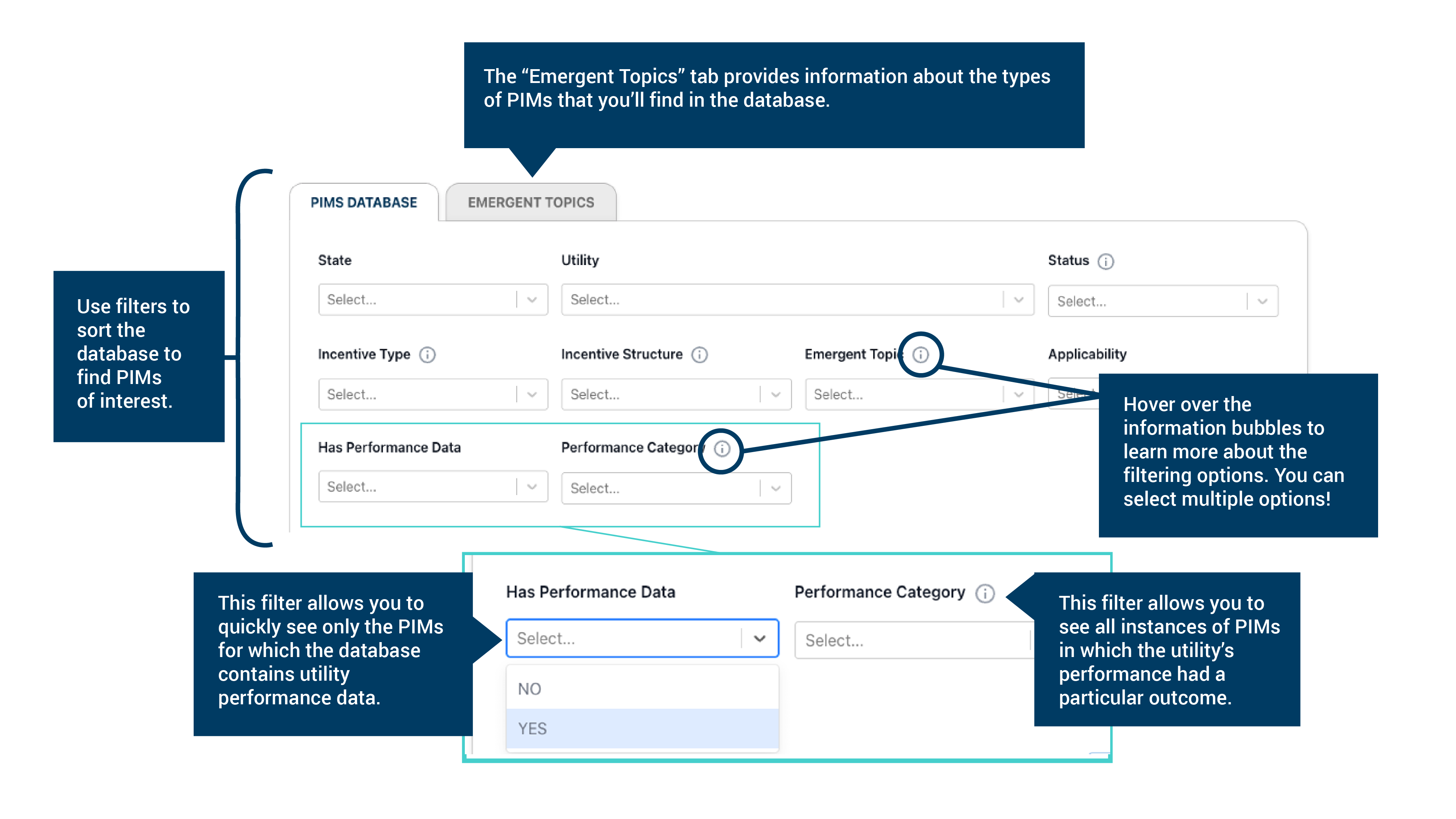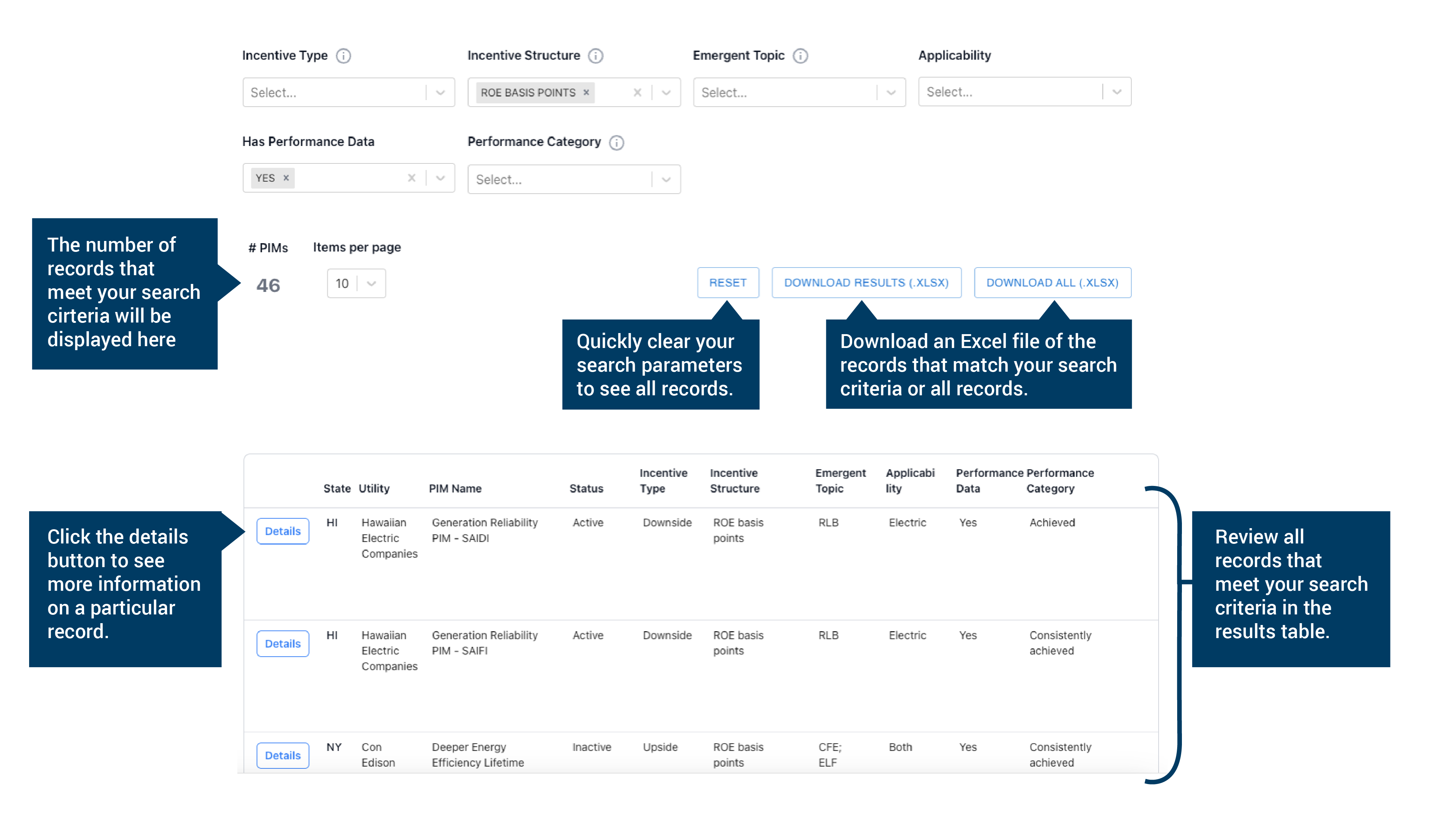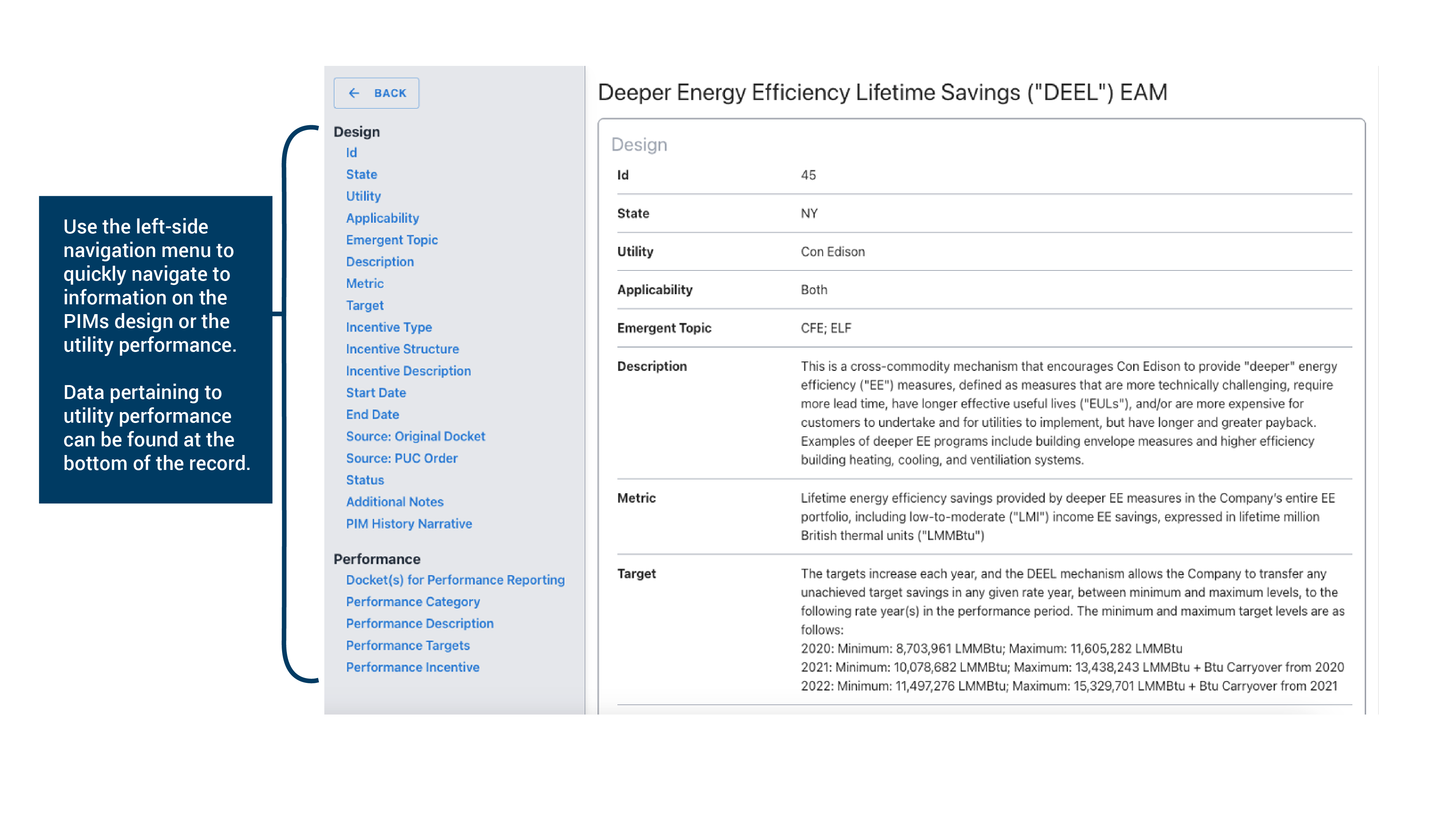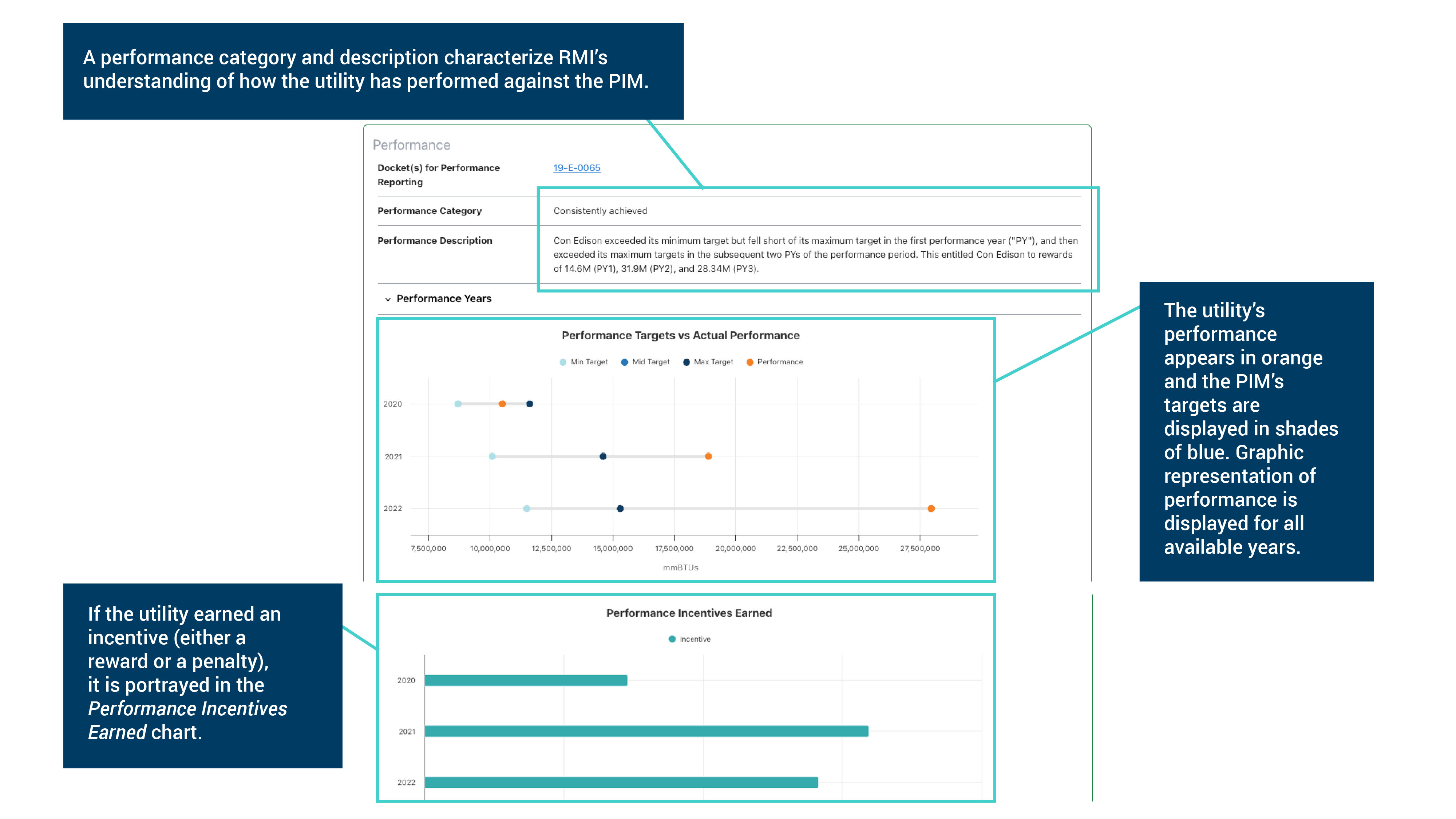PIMs Database
Emergent Performance Mechanisms across the United StatesWelcome to the PIMs Database, the place to find comprehensive information on emergent performance incentive mechanisms (PIMs) across the United States. (For background on what a PIM is and why RMI created this database, please visit the FAQ page.)
The database below is designed to be filterable by a number of factors, including state, utility, status (i.e., active or inactive), incentive type, incentive structure, emergent topic area, and how the utility performed towards the PIM's targets. You can download the database in full or based on specific filter result parameters, and each download of the database is timestamped for easy reference as PIMs progress over time. The emergent topics tab provides a description for each topic, as well as links to additional information for some of the emergent topics in the database.
| State | Utility | PIM Name | Status | Incentive Type | Incentive Structure | Emergent Topic | Applicability | Performance Data | Performance Category |
|---|
Emergent topics are the subset of regulatory outcomes that represent new or evolving areas of utility performance expectations. The table below describes each emergent topic, and in some cases, provides links to additional information on the topic. PIMs in the database are frequently assigned to multiple emergent topics.
| Full Name | Abbreviation | Description | Additional Resources |
|---|---|---|---|
Affordability | AFD | Mechanisms focused on: • Measuring and/or incentivizing increased customer affordability • Disconnections and/or arrearage management • Low-or-moderate income (LMI) communities These qualify as affordability, unless they also denote one or more specific equity communities, in which case the mechanism would qualify as both affordability and equity. | |
Climate Forward Efficiency | CFE | Climate-forward efficiency refers to energy efficiency or demand-side management that is explicitly measured in greenhouse gas (GHG) reduction or is explicitly connected to the policy goal of reducing GHGs in the order approving the implementation of a PIM. | |
Cost Control | CC | Mechanisms designed with the intent to reduce overall costs including PIMs whose intent is focused on cost control but not measured in monetary value, as well as PIMs tied to cost. | |
Customer Engagement | CE | Mechanisms that reflect an interest in improving the customer experience and/or increasing customer understanding. | |
Demand Flex | DF | Mechanisms focused on shifting demand throughout the course of the day, including the strategies of shape, shift, shimmy, shed. As such, mechanisms focused on reduction of peak load are included in this category. | Elliot Nethercutt, |
Distributed Energy Resources | DER | Mechanisms focused on increasing distributed energy resource utilization and efficacy, and/or encouraging utility investment in non-wires alternatives (NWA), also frequently called non-wires solutions (NWS). For the purposes of this database, we use the 2017 Smart Electric Power Alliance's definition of DERs: "The physical and virtual assets that are deployed across the distribution grid, typically close to load, and usually behind the meter, which can be used individually or in aggregate to provide value to the grid, individual customers, or both." | Jeff Ressler, Clean Power Research |
Equity | EQ | Mechanisms that specifically note disproportionately impacted communities, which include recognizing the different experiences of certain types of customers, just transition, environmental justice, and/or energy burden. | Chandra Farley et al., Lawrence Berkeley National Laboratory |
Electrification | ELF | Mechanisms measuring or incentivizing the outcome of electrification of buildings or other sectors; transitioning from gas or other fuels to electricity. | |
Transportation Electrification | TE | Mechanisms focused on or pertinent to the electrification of the transportation sector. | |
Greenhouse Gas Emissions | GHG | Mechanisms attributed to the goal or outcome of greenhouse gas emissions reduction (methane or carbon dioxide or carbon dioxide equivalent), either as a direct measurement of GHGs or as the policy goal or intent behind a specific mechanism. | |
Grid Modernization | GM | Mechanisms focused on grid modernization, which may include enhanced utilization and efficacy of the grid, advanced metering infrastructure, etc. | |
Fuel Cost Mechanisms | FCM | Mechanisms that create utility “skin in the game” for fuel and purchased power costs, exposing utility shareholders (not just customers) to a portion of price volatility risk. Specific cost sharing mechanisms vary utility-by-utility and state-by-state. However, the underlying principle is typically the same: when a utility’s actual incurred fuel and power supply costs exceed an approved threshold, shareholders pay a portion of the costs (in the form of a penalty), and when a utility’s actual incurred fuel and power supply costs are below an acceptable threshold, shareholders earn a portion of the savings (in the form of a reward). | Joe Daniel et al., RMI, 2023 |
Reliability | RLB | Mechanisms designed to improve the ability of a power system to withstand instability, uncontrolled events, cascading failures, or unanticipated loss of system components. However, for the purposes of this database, the focus is on mechanisms that represent emerging focus of the reliability industry, such as reliability for certain segments of the grid, for certain communities, or that is measured in a novel way (i.e., beyond SAIDI/SAIFI). | |
Renewables | RE | Mechanisms intended to support the deployment of utility-scale reneawables. | |
Federal Funding | FF | Mechanisms intended to encourage utilities to effectively implement the Inflation Reduction Act (IRA), Infrastructure Investment & Jobs Act (IIJA), and other relevant federal funding policies, including by encouraging utilities to take advantage of available tax credits, incentives, and grant opportunities. |




This chart shows the quantity of PIMs by (a) the emergent topic(s) they are intended to support, and (b) the portions of the utility’s business to which the PIM is applicable (i.e., to an electric-only utility or the electric portion of a utility business, a gas-only utility or to the gas portion of a utility’s business, or to both the gas and electric businesses for a dual utility). The list and definitions of emergent topics (i.e., outcomes) included in the database can be found on the emergent topic tab. Click on the column headings to change the sorting order of the emergent topics to be alphabetical, by total count in descending order, or by the count of PIMs applicable to electric, gas, or both.
This chart shows utility performance category trends by emergent topic. For each topic, green shaded bars indicate the frequency with which utilities have achieved a target and earned a reward, and grey bars indicate the frequency with which utilities have not achieved the PIMs’ targets.
This map shows the total count of PIMs in the database by state in which they are applied. Use the toggle in the upper left corner to adjust the map to show only PIMs that are currently active.
# PIMs
This chart shows the count of PIMs in the Database by incentive structure and the incentive type. The incentive structure refers to the way in which the incentive is allocated when the PIM is designed (e.g., a fixed dollar amount for a prescribed target, a share of the savings or benefits created, ROE basis points, or a percentage adder on a budget or other prescribed revenues). There are three types of mechanisms in the database: upside-only, meaning the PIM provides an opportunity for reward-only; symmetrical, meaning the PIM provides both an opportunity for reward and penalty; or downside-only, meaning the PIM provides an opportunity for penalty only.
This chart shows the total annual dollar value of incentives earned for PIMs in the database for which utility performance and earnings data is publicly available. The earnings are broken apart by the incentive type associated with the PIMs for which a utility earned an incentive.